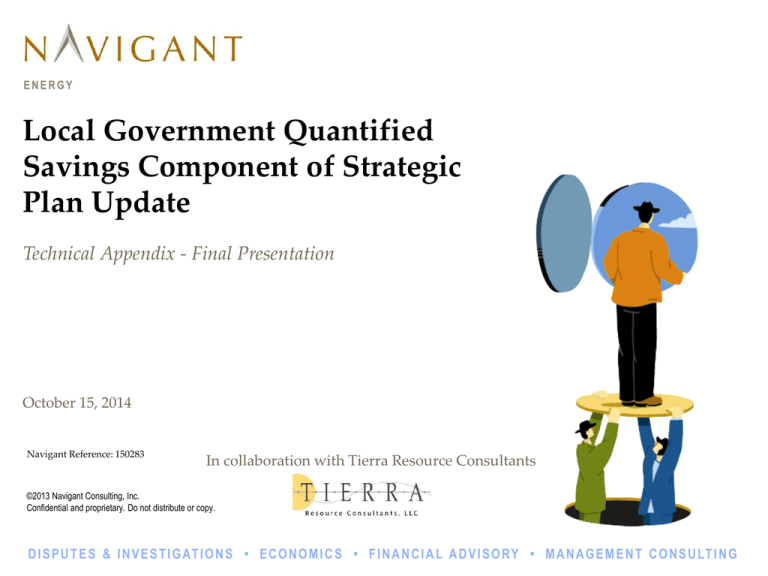LG Action Plan Metrics - Energy Efficiency Coordinator
advertisement

ENERGY Local Government Quantified Savings Component of Strategic Plan Update Technical Appendix - Final Presentation October 15, 2014 Navigant Reference: 150283 In collaboration with Tierra Resource Consultants ©2013 Navigant Consulting, Inc. Confidential and proprietary. Do not distribute or copy. D I S P U T E S & I N V E S T I G AT I O N S • E C O N O M I C S • F I N A N C I A L A D V I S O RY • M A N A G E M E N T C O N S U LT I N G Meeting Protocols Meeting Protocols • For the webinar unplugged to be a success, all callers will need to have their phones set to mute. • Slides for the presentation should be downloaded from http://eecoodinator.info well in advance of the webinar. • Participants should call in five minutes prior to the start of the webinar. The line will accommodate 100 participants. First come, first served. • (866) 630-5989, Access Code 336 2110# • The presenter will prompt participants when it is time to advance to the next slide. • At the conclusion of each section of the presentation, the host will pause to ask if there are questions, at which point, callers with questions may unmute. • At these question times and at the conclusion of the presentation, questions may also be emailed to the presenter at Jeremy.Battis@cpuc.ca.gov. • All parties posing questions will have themselves and their agency identified. ©2013 Navigant Consulting, Inc. Confidential and proprietary. Do not distribute or copy. 1 ENERGY Meeting Agenda and Project Objectives Meeting Goals and Agenda 1. Quick review of project objectives. 2. Quick review of the methods used to establish energy efficiency metrics (i.e. EE potential) for goals 1, 3, and 4. 3. Present final energy metrics for goals 1, 3, and 4. 4. Present insight into additional sources of EE savings for LG’s that are not included in the metrics. 5. Discuss limitation of the analysis. 6. Discuss recommendations. Project Objectives 1. Establish energy metrics (i.e. EE potential) for goals 1, 3, and 4 for the Local Government EE Strategic Plan Action Plan. a. Note that Navigant did not develop a metric for Goal #2 because metrics for that goal did not align with the Potential and Goals Study model. 2. Define a template that could be used to establish EE goals and metrics for other components of the California Strategic Energy Plan. ©2013 Navigant Consulting, Inc. Confidential and proprietary. Do not distribute or copy. 2 ENERGY Methodology for Goal #1 Method for Estimating Goal #1 • First the team estimated baseline LG energy usage for each IOU territory based stakeholder discussions and data obtained from IOUs on 2012 electricity and natural gas sales. • A ratio was then develop by dividing the LG baseline usage by the full commercial sector usage. Technical Appendix Table 7. Estimated LG Facilities Consumption as a Percent of Commercial Consumption IOU Fuel Type PG&E SCE SDG&E PG&E SDG&E SCG Electric Electric Electric Gas Gas Gas LG Facilities Share of Commercial Sector Consumption* 3.38% 3.36% 3.37% 2.01% 1.44% 1.72%* • This ratio was then used to estimate LG potential as a percent of total commercial market technical, economic, and market potential. ©2013 Navigant Consulting, Inc. Confidential and proprietary. Do not distribute or copy. 3 ENERGY Methodology for Goal #1 - Example of LG Energy Consumption Technical Appendix Figure 2. 2012 PG&E Local Government Electric Energy Sales Distribution by System PG&E 2012 LG Related Energy Sales 13% 11% 16% Electricity sales are distributed between; • Facilities • Street lights • Water supply • Waste water treatment 60% Facilities Water Supply-Irrigation System Sewage Treatment Facilities Street lights Technical Appendix Figure 3. 2012 PG&E Local Government Gas Energy Sales Distribution by System 27% Natural gas sales are distributed between; • Power generation • Facilities 73% Fossil Fuel Electric Power Generation ©2013 Navigant Consulting, Inc. Confidential and proprietary. Do not distribute or copy. Facilities 4 ENERGY Proposed Metrics for Goal 1 Technical Appendix Figure 6. Goal 1 Incremental Annual GWh Goal 1 Local governments lead by example by designing and implementing programs that reduce their own energy use and greenhouse gas emissions Goal 1 Metrics Between 2015 and 2020, achieve an average annual incremental ex-post gross savings of 27 GWh and 0.2 MM Therms from the implementation of standard efficiency measures (i.e., measures eligible for IOU rebates) captured in facilities owned and/or occupied by LGs. ©2013 Navigant Consulting, Inc. Confidential and proprietary. Do not distribute or copy. Technical Appendix Figure 7. Goal 1 Incremental Annual MMTherms 5 ENERGY Methodology for Goal #3 Method for Estimating Goal #3 • The 2013 potential included the capability to increase code compliance over time. • Assume baseline code compliance rate increases by 10 percentage points. • Applies to constituent and LG facilities. • Applies to new construction and retrofit/replace on burnout. • Attribution of savings from advocacy and code compliance enhancements to be established between LG and affiliated IOU. ©2013 Navigant Consulting, Inc. Confidential and proprietary. Do not distribute or copy. 6 ENERGY Proposed Metrics for Goal 3 Technical Appendix Figure 8. Goal 3 Incremental Annual GWh Goal 3 Local governments accelerate the implementation of energy efficiency, zero net energy and greenhouse gas reduction goals through the use of their regulatory authority. Goal 3 Metrics Between 2015 and 2020, achieve an average annual incremental ex-post gross savings of 29 GWh and 0.1 MM Therms from an increase of 10 percentage points in compliance with existing codes for new construction and renewal/renovation projects. ©2013 Navigant Consulting, Inc. Confidential and proprietary. Do not distribute or copy. Technical Appendix Figure 9. Goal 3 Incremental Annual MMTherms 7 ENERGY Methodology for Goal #4 Method for Estimating Goal #4 • Navigant assumes that the aggregate results from goals 1, 2, and 3, in combination with improvements in overall energy management, will increase the potential for energy. • Improving energy management is a process and can occur in many ways. One example of this process might include the following 5 steps; 1. Include a complete analysis of historic usage load sources and load profiles. 2. Develop a clear and accurate understanding of the potential for energy efficiency that is based on engineering analysis such as technical potential audits, and covers the full scope of LG operations. 3. Establish the ability to develop and use guidance documents, such as strategic energy plans, to organize and direct sustained efforts at achieving energy efficiency over a long time horizon. 4. Organize an effective management structure that includes the ability to transition authority and commitment to a strategic approach to energy management as staff positions evolve and turnover occurs, and 5. Continuously improves the project delivery process to include increasingly complex projects that include data rich and real-time energy management capability. • Metrics for goal 4 were estimated by multiplying the mid case scenario potential provided in goal #1 by a factor of 1.25. ©2013 Navigant Consulting, Inc. Confidential and proprietary. Do not distribute or copy. 8 ENERGY Methodology for Goal #4 - Example of improving energy management as a process. A Comparison of EE Savings Achieved by Two Similar Institutions 250,000,000 Energy Saved (kWh) 200,000,000 Bond funding for EE projects authorized by management 150,000,000 100,000,000 Strategic Energy Plan formally adopted 50,000,000 Date Institution 1 ©2013 Navigant Consulting, Inc. Confidential and proprietary. Do not distribute or copy. Institution 2 9 ENERGY 12-12 10-12 08-12 06-12 02-12 04-12 12-11 10-11 08-11 06-11 02-11 04-11 12-10 10-10 08-10 06-10 02-10 04-10 12-09 10-09 08-09 06-09 02-09 04-09 12-08 10-08 08-08 06-08 02-08 04-08 12-07 10-07 08-07 06-07 02-07 04-07 12-06 - Proposed Metrics for Goal 4 Technical Appendix Figure 10. Goal 4 Incremental Annual GWh Goal 4 Local government and private sector energy management expertise becomes widespread and prevalent. Goal 4 Metrics Between 2015 and 2020, achieve an average annual incremental ex-post gross savings of 7 GWh and 0.05 MM Therms in addition to the metrics stated for goal 1. ©2013 Navigant Consulting, Inc. Confidential and proprietary. Do not distribute or copy. Technical Appendix Figure 11. Goal 4 Incremental Annual MMTherms 10 ENERGY Proposed Metrics Summary Local government incremental market EE potential, by goal (GWh) • Applies to consumption associated with facilities. • Does not include potential for street lighting and water delivery / waster water treatment. • Goals 1 and 4 are for LG owned/operated facilities. • Goal 3 represent 10% improvement in compliance for both new construction and retrofit/replace on burnout projects for LG and constituent facilities. • These goals indicate the potential exists to reduce electricity consumption in local government operated facilities by approximately 16% to 20%. • This represented an estimated total reduction in annual LG electricity spend of approximately 9% to 12%. Technical Appendix Table 1. Local Government Strategic Plan Update Incremental Market EE Potential, by Goal (GWh) Year 2015 2016 2017 2018 2019 2020 2021 2022 2023 2024 Goal 1 29.6 30.9 29.1 20.9 23.4 27.1 30.6 34.3 37.8 41.4 Goal 3 32.6 56.8 32.1 22 18.3 13 7.1 3.6 1.7 1.1 Goal 4 7.4 7.7 7.3 5.2 5.8 6.8 7.7 8.6 9.4 10.3 Total 69.7 95.4 68.5 48.1 47.5 46.9 45.3 46.4 48.9 52.8 ©2013 Navigant Consulting, Inc. Confidential and proprietary. Do not distribute or copy. 11 ENERGY Additional Potential for EE not in Metrics Additional source of EE savings not in metrics • Street lights. • • For example, in PG&E’s service territory, streetlights are about 13% of total LG spend on electricity in 2012. Water delivery and waste water treatment facilities. • For example, in PG&E’s service territory, wastewater treatment and water supply are about 11% and 16%, respectively, of total LG spend on electricity in 2012. Technical Appendix Figure 2. 2012 PG&E Local Government Electric Energy Sales Distribution 13% 11% 60% 16% Facilities Water Supply-Irrigation System Sewage Treatment Facilities Street lights ©2013 Navigant Consulting, Inc. Confidential and proprietary. Do not distribute or copy. 12 ENERGY Additional Potential for EE not in Metrics – Street lighting • The potential for street lights was reviewed in detail in the 2013 potential model. • As shown in figure 13, the potential exists to reduce streetlight energy use by about 45% through a mix of LED and induction lamp technologies and advanced controls. • Potential varies by IOU according to who owns the lighting. • Overall, the potential exists to reduce annual local government sector electricity consumption by about 7%. Technical Appendix Figure 13. California Street Lighting Savings Potential as a Percent of CEC Street Lighting Forecast (Technical and Active Cumulative Market Potential) 80% 70% 60% GWh 50% 40% 30% 20% 10% 0% 2012 2013 2014 Technical Potential ©2013 Navigant Consulting, Inc. Confidential and proprietary. Do not distribute or copy. 2015 2016 2017 2018 2019 Economic Potential 2020 2021 2022 2023 2024 Mid Cumulative Market Potential 13 ENERGY Additional Potential for EE not in Metrics – Street lighting Street lighting ownership distribution and annual incremental potential for LGs, by territory. Technical Appendix Table 2. Street Lighting Ownership, by Lamp Count IOU IOU-Owned CustomerOwned Statewide 57.1% 42.9% PG&E 26.3% 73.7% SCE 82.4% 17.6% SDG&E 19.0% 81.0% Technical Appendix Table 16. Total LG Streetlight Market Potential (GWh) Year 2015 2016 2017 2018 2019 2020 2021 2022 2023 2024 PG&E 11 11 10 9 8 8 7 7 7 6 SCE 3 4 4 4 4 4 4 4 4 4 SDG&E 1 1 1 1 1 1 1 1 1 1 Total 15 15 15 14 13 12 12 12 12 11 ©2013 Navigant Consulting, Inc. Confidential and proprietary. Do not distribute or copy. 14 ENERGY Additional Potential for EE not in Metrics – Water supply and waste water treatment • The 2013 potential model did not analyze water supply and waste water treatment. • Navigant undertook a quick very, high level literature review that indicates savings potential across all water service operations is over 4%. • Overall, the potential exists to reduce total annual local government sector electricity consumption by about over 1%. • Potential should be studied in detail. Technical Appendix Table 35. Top Energy Savings Opportunities for LG Water Management Water Service Type Measure Upper Bound Savings % of End-Use Consumption Potable & Non-Potable Improved Motor Efficiency 6% 4.0% 5.0% 0.2% Potable & Non-Potable Pump System Optimization 20% 12.4% 10.0% 1.0% Potable & Non-Potable VFDs 50% 27.5% 10.0% Potable & Non-Potable Supervisory Control and Data Acquisition (SCADA) 20% 15.0% 5.0% Non-Potable High Efficiency Aeration Blowers 35.0% 10.0% Potable & Non-Potable Other Potable & Non-Potable ©2013 Navigant Consulting, Inc. Confidential and proprietary. Do not distribute or copy. Average Savings % of End-Use Consumption Market Applicability Factor NA Potable & Non-Potable Total End-Use to Sector Adjustment Factor 80.0% Applicable Average Savings % of Total Sector Consumption 2.2% 4.3% 0.6% 8.8% % Savings Potential for all Water Service Consumption 0.3% 11.2% 100.0% 15 ENERGY Limitations of the Analysis Limitations of the Analysis • Since the PGT model was developed for a different purpose than the Strategic Plan metrics, the results provided in this technical appendix represent order-of-magnitude, directional opportunities rather than precise estimates of potential for any single local government, end use measure category, or building type. • The metrics for Goals 1 and 4 are specific for facilities for which local governments either owns the building, or for which they are the utility account holder of record. Many local governments are engaged with their communities to promote energy efficiency and create additional energy efficiency momentum with their constituents. These metrics for goals 1 and 4 do not include constituent facilities and do not reflect potential for LG constituent outreach efforts. • Estimates of energy efficiency potential are limited by the requirements of the Potential, Goals, and Targets (PGT) project. The PGT work is based on all measures that will screen in a TRC cost test, and meet all other criteria for inclusion in IOU incentive type programs. Additional potential may be available under different TRC cost effectiveness thresholds or different cost effectiveness tests. • The analysis of the potential for municipal water operations is preliminary and illustrative in nature, and should be viewed as an order of magnitude estimate only. ©2013 Navigant Consulting, Inc. Confidential and proprietary. Do not distribute or copy. 16 ENERGY Limitations of the Analysis Recommendations • Further research should be completed through the CPUC potential modelling efforts to refine estimates of energy efficiency potential in water systems operated by local governments. • The savings associated with goal 3 include savings from codes and standards related activities at LG facilities, and also constituent facilities. A more accurate assessment of this goal could be accomplished by more clearly establishing the relationship between IOU programs and LG activities in the realm of codes and standards. • As new program delivery mechanisms that involve local governments are developed, such as PACE financing and regional energy networks (RENs), it is likely new sources of savings will be defined, and new methods to develop that potential will be implemented. In order to capture this potential, future revisions to the strategic plan metrics should be expanded beyond the definition of potential used in the 2013 potential study. • Additional data on energy sales to LGs from SCE and SDG&E would allow more specific direction on where energy efficiency potential might be clustered at LGs operating in the service territories for these utilities. • Additionally, most cities and counties have developed energy action plans (EAPs) as part of their carbon action planning process. These EAPs include details on usage for the three categories discussed above. The research team could not identify a source where all information from these EAPs has been collected and warehoused. Such a database would help further define where potential exists and how it could be most effectively captured. ©2013 Navigant Consulting, Inc. Confidential and proprietary. Do not distribute or copy. 17 ENERGY











